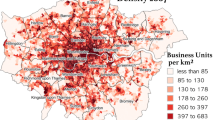Abstract
This paper provides an empirical framework that applies spatial statistics methods to assess the relation between the change in the geographical clustering of firms and the emergence of urban form. We contend that where firms locate and eventually cluster give rise to the way commercial and industrial land uses are organized over space, which in turn defines the shape of urban form. Accordingly, the objectives of our work are twofold: (1) to identify the extent and shape of firm clustering and co-location at the intra-metropolitan level, and (2) examine how the change in the geographic clustering of different industries contributes to decentralization and the evolution of urban form. Spatial statistics methods and tools were vital and helped to fulfill these objectives.






Similar content being viewed by others
References
Anas A, Arnott R, Small K (1998) Urban spatial structure. J Econ Lit XXXVI:1426–1464
Anselin L, Syabri J, Kho Y (2006) Geoda: an introduction to spatial analysis. Geogr Anal 38:5–22
Bailey T, Gatrell A (1995) Interactive spatial data analysis. Addison-Wesley, Harlow
Barff R (1987) Industrial clustering and the organization of production: a point pattern analysis of manufacturing in Cincinnati, Ohio. Ann Assoc Am Geogr 77:89–103
Barff R, Hewitt D (1989) Second-order analysis of bivariate point pattern. Prof Geogr 41:183–189
Bourne L (1989) Are new urban forms emerging? Empirical tests for Canadian urban areas. Can Geogr 33:312–328
Bracken I, Martin D (1989) The generation of spatial population distribution from census centroid data. Environ Plann A 21:537–543
Britton J (2003) Network structure of an industrial cluster: electronics in Toronto. Environ Plann A 35:983–1006
Cuthbert A, Anderson W (2002) Using spatial statistics to examine the pattern of urban land development in Halifax-Dartmouth. Prof Geogr 54:521–532
Erickson R, Wasylenko M (1980) Firm relocation and site selection in suburban municipalities. J Urban Econ 8:69–85
Feser E, Sweeney S (2000) A test for the coincident economic and spatial clustering of business enterprises. J Geogr Syst 2:349–373
Frankhauser P (2000) GIS and fractal formalization of urban patterns: towards a new paradigm for spatial analysis. In: Fotheringham A, Wegener M (eds) Spatial models and GIS: new potential and new models. Taylor & Francis, London, pp 121–141
Frenkel A (2001) Why high technology firms choose to locate in or near metropolitan areas. Urban Stud 38:1083–1102
Glaeser E, Kallal H, Scheinkman J, Shleifer A (1992) Growth in cities. J Polit Econ 100:1126–1152
Getis A (1983) Second order analysis of point patterns: the case of Chicago as a multi-center urban region. Prof Geogr 35:73–80
Gordon I, McCann P (2000) Industrial clusters: complexes, agglomeration and/or social networks?. Urban Stud 37:513–532
Griffith D, Wong D (2006) Modeling population density across major US cities: a polycentric spatial regression approach. J Geogr Syst (this issue)
Hanson G (1996) Agglomeration, dispersion and the pioneer firm. J Urban Econ 39:255–281
Ihlanfeldt K, Raper M (1990) The intrametropolitan location of new office firms. Land Econ 66:182–198
Krugman P. (1991) Geography and trade. MIT press, Cambridge, MA
Maoh H, Kanaroglou P, Buliung R (2005) Modeling the location of firms within an integrated transport and land-use model for Hamilton, Ontario. Working paper no. 6, Center for Spatial Analysis (CSpA), McMaster University, Hamilton
Maoh H (1999) Developing an employment location model for the hamilton census metropolitan area (CMA). Masters Thesis, School of Geography and Geology, McMaster University
Maoh H (2005) Modeling firm demography in urban areas with an application to Hamilton, Ontario: towards an agent-based microsimulation model. PhD Thesis, School of Geography and Earth Sciences, McMaster University
Marshall A (1920) Principles of economics. McMillan, London
McMillen D, McDonald J (1998) Suburban subcenters and employment density in metropolitan Chicago. J Urban Econ 43:157–180
Miller R, Blair P (1985) Input--output analysis: foundations and extensions. Prentice-Hall, Inc., Englewood Cliffs
Rigby D, Essletzbichler J (2002) Agglomeration economies and productivity differences in US cities. J Econ Geogr 2:407–432
Rosenthal S, Strange W (2003) Geography, industrial organization and agglomeration. Rev Econ Stat 85:377–393
Shearmur R (2006) The clustering and spatial distribution of economic activities in eight Canadian cities. Int J Entrepreneurship Innov Manage (forthcoming)
Shearmur R, Coffey W (2002) Urban employment subcentres and sectoral clustering in Montreal: complementary approaches to the study of urban form. Urban Geogr 23:103–130
Shukla V, Waddell P (1991) Firm location and land use in discrete urban space: a study of the spatial structure of Dallas-Fort Worth. Reg Sci Urban Econ 21:225–253
Simmie J (1998) Reasons for the development of ‘islands of innovation’: evidence from Hertforshire. Urban Stud 35:1261–1289
Small K, Song S (1994) Population and employment densities: structure and change. Journal of Urban Economics 36:292–313
Smith D, Florida R (1994) Agglomeration and industrial location: an econometric analysis of Japanese-affiliated manufacturing establishments in automotive-related industries. J Urban Econ 36:23–41
Statistics Canada (2003) Canadian business patterns database. Statistics Canada, Ottawa
Suarez-Villa L, Walrod W (1997) Operational strategy, R & D and intra-metropolitan clustering in a polycentric structure: the advanced electronics industry of the Los Angeles basin. Urban Stud 34:1343–1380
Torrens P, Alberti M (2000) Measuring sprawl. In proceedings of the Association of collegiate schools of planning conference, Atlanta
Waddell P, Shukla V (1993) Manufacturing location in a polycentric urban area: a study in the composition and attractivness of employment subcenters. Urban Geogr 14:277–296
Waddell P, Borning A, Noth M, Freier N, Becke M, Ulfarsson G (2003) Microsimulation of urban development and location choices: design and implementation of UrbanSim. Netw Spat Econ 3:43–67
Wu F (1999) Intrametropolitan FDI firm location in Guangzhou, China: a poisson and negative binomial analysis. Ann Reg Sci 33:535–555
Acknowledgment
The authors are thankful to Antonio Páez and four anonymous referees for their revisions and constructive suggestions.
Author information
Authors and Affiliations
Corresponding author
Rights and permissions
About this article
Cite this article
Maoh, H., Kanaroglou, P. Geographic clustering of firms and urban form: a multivariate analysis. J Geograph Syst 9, 29–52 (2007). https://doi.org/10.1007/s10109-006-0029-6
Published:
Issue Date:
DOI: https://doi.org/10.1007/s10109-006-0029-6




